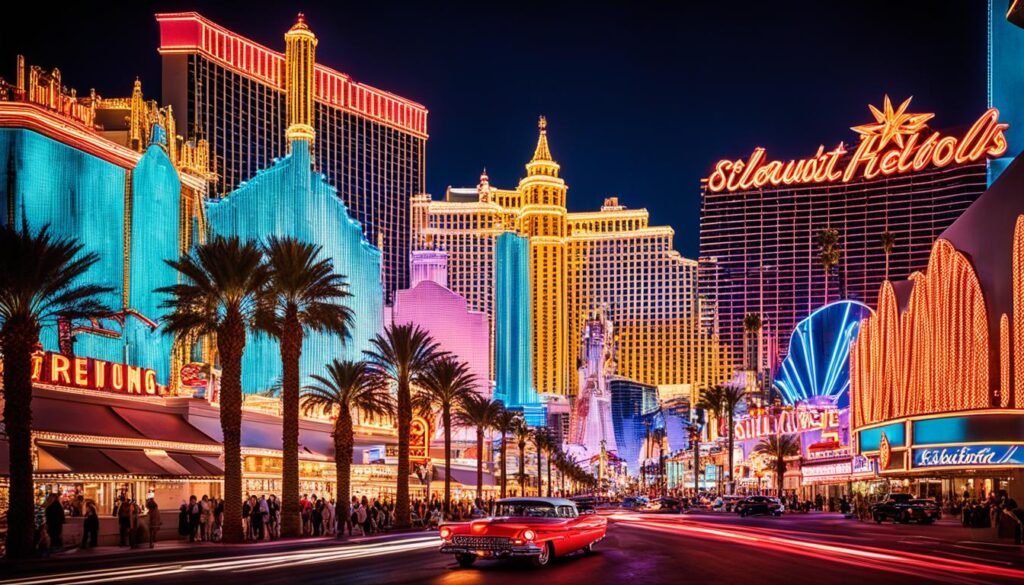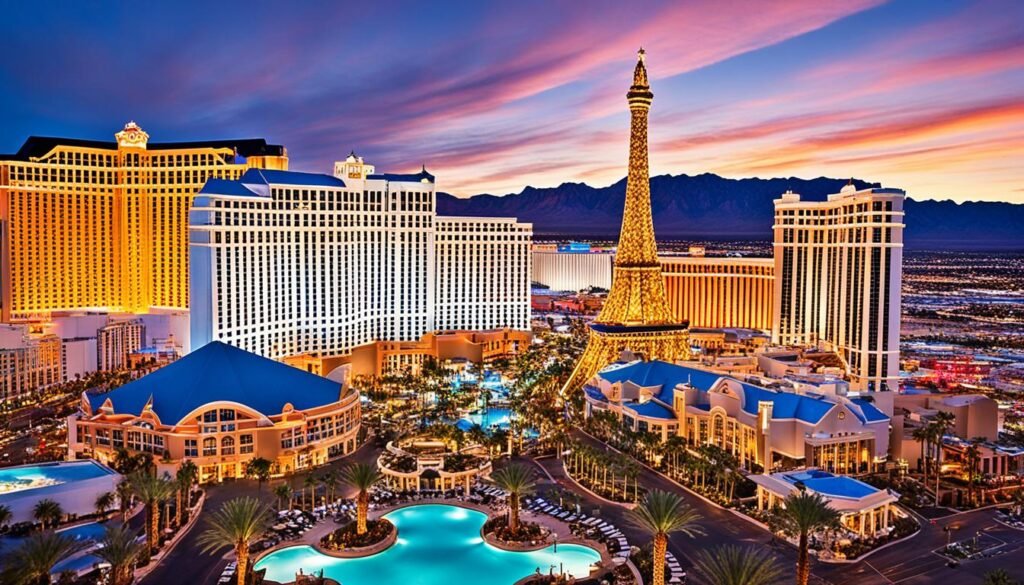Las Vegas – Discover the captivating history and present-day allure of this iconic entertainment capital, from its humble beginnings to its vibrant casinos, hotels, and nightlife.
The city of Las Vegas stands as the world’s most famous entertainment hub. It dates back over a hundred years. In fact, it was once just a spot in the desert, but it is now an international draw. This place shines with its gambling, top hotels, and big events. Each year, millions of tourists flock to this iconic destination for fun, sun, relaxation, thrills and excitment.
What changed Las Vegas from a barren land into this sparkling welcome for millions? That’s a tale of daring, missteps, and clever turns. The city’s rise shows how people can change their world with big dreams and hard work.
Key Takeaways
- Las Vegas was officially founded in 1905 when 110 acres of land were auctioned off by the railroad company.
- The population of Las Vegas grew from 5,000 to 25,000 during the construction of the Hoover Dam from 1931 to 1935.
- The Las Vegas Strip, a 4.2-mile stretch of road, was established in the city and now features famous hotels like the Flamingo, Caesars Palace, and the Bellagio.
- Las Vegas was transformed into the country’s fastest-growing metropolis by the end of the 20th century.
- The city of Las Vegas had a population of 641,903 by 2020, and the Las Vegas–Paradise Metro Area had a population of approximately 2,265,461 by the same year.
The Birth of Las Vegas (1905-1929)
In 1905, the city of Las Vegas was born through a land auction. Then, the railroad sold 110 acres of land, marking the city’s official start, with this land eventually became the heart of the city, known as the downtown area.
Incorporation and the First Mayor
Las Vegas became a city in 1911 under Clark County, Nevada. Peter Buol became its first mayor. By 1913, he had helped the city get on its feet. This was the start of growth into a major spot for gambling, entertainment, and tourism.
The Hoover Dam Project
The Hoover Dam was built near Las Vegas, bringing many workers to the city which in turn increased the demand for entertainment in the city. Soon, the city’s population jumped from 5,000 to 25,000 during the dam’s construction from 1931 to 1935. This marked the first of many booms to the metropolis.
The Arrival of the Mafia
With the growing gambling and entertainment scene, the mafia took notice.Seizing the op A casino opened during the Hoover Dam construction, targeting the workers. This started the city’s connection with the mafia and its influence on the city’s future.
The Golden Age (1930-1960)
From the 1930s to the 1960s, Las Vegas shone bright. It became a top spot for fun and games. In these years, the city grew quickly. It went from having only 5,000 people in 1931 to 25,000 in 1935.
The city welcomed big stars with giants like Frank Sinatra, Liberace, and Sammy Davis Jr. performed at famous spots in Las Vegas. The amazing Rat Pack put on shows that made the city famous worldwide.
Not just stars, but mobsters also made their mark. Bugsy Siegel and Meyer Lansky were well-known. They ran big casinos and hotels, adding to the city’s lively, yet risky reputation.
Despite all the excitement, prostitution found its place too. The Red Light District, or Block 16, did business near the bright lights of the city.
The Strip
The Las Vegas Strip is a 4.2-mile road hosting top hotels and casinos. It began with El Rancho Vegas in 1941. Thomas Hull’s hotel-casino was the first to offer big features like air conditioning and a pool.
El Rancho Vegas
The El Rancho Vegas was the first with a western style and fun shows. It laid the foundation for the Las Vegas Strip as a key entertainment spot. This hotel started a trend leading to the Strip’s famous casinos and hotels.
The Sahara Hotel and the African Theme
In 1952, the Sahara Hotel brought an African feel to the Strip. Its design, with a Moroccan front and wild animal sights, was unique. This added more variety to the Strip’s fun.
The Expansion of the Las Vegas Strip
Over time, the Vegas Strip grew with more famous hotels and casinos. Places like the grand Caesars Palace and the fun Circus Circus joined the mix. They made the Strip more welcoming to all kinds of visitors. Today, it’s the top place for fun in America.
Post-War Las Vegas (1950-1960)
The 1950s and 1960s were a golden time for Las Vegas with the population booming, welcoming many tourists and new residents. The city was quickly becoming known worldwide for its lively entertainment scene. Rat Pack performers Frank Sinatra, Dean Martin, and Sammy Davis Jr. helped push it into fame as the entertainment capital of the world.
The Rat Pack and Entertainment
The Rat Pack brought glamor and excitement to post-war Vegas. Their thrilling performances at the Sands Hotel and Casino were very popular. Besides the Rat Pack, big names like Bing Crosby also performed in Las Vegas, which drew huge crowds.
The Mobsters and Casinos
The casino scene in Vegas from the 1950s to 1960s had its share of issues. Its growing reputation for fun and games attracted mobsters and organized crime. Key figures like Benny Binion and Louis Prima set up casinos like Binion’s Horseshoe and Sahara Hotel. They had help from the Teamsters Union and opportunistic bankers.
The Red Light District and Prostitution
Besides the casino and entertainment growth, “Sin City” also saw a rise in the red light district and prostitution from the 1950s to 1960s. As a result oThe city’s open mindset and reputation for accepting all attracted a darker side, with illegal activities showing up now and then. For example, the story of Sheriff Glen Jones involved in sinister deals shed light on the hidden criminal world. Eventually the authorities shut it down, but “Sin City” still remembers this tawdry era.

| Statistic | Value |
|---|---|
| Population growth in Las Vegas Valley (1940s to 1950s) | From 8,422 to over 45,000 |
| Annual visitors to Las Vegas (1954) | Over 8 million |
| Casino industry revenue (1954) | $200 million |
| Iconic casinos established (1952-1957) | Sahara, Sands, New Frontier, Riviera, Tropicana |
Las Vegas in the 1960s and 1970s
The 1960s and 1970s were times of big growth, bringing new casinos and hotels to the Las Vegas Strip. Places like the Aladdin, Caesars Palace, and Circus Circus started welcoming guests.
The 1960s were vitally important in Vegas, with the Rat Pack’s cool shows still wowing audiences at the Sands. This made the city the hottest venue for fun and games around the world.
In 1969, Elvis Presley performed at the International and his shows helped Las Vegas become even more popular with tourists. But, in the 1970s, people started to see Las Vegas as a bit cheap, with other places like Atlantic City trying to take its place.
Las Vegas didn’t let this slow it down though because In 1973, the MGM Grand opened, becoming the world’s biggest hotel and casino. Around the same time, Merv Griffin’s talk show and the show Vega$ started, showing the world Las Vegas‘ glitz and glamour.
This, however, was not enough to revitalize “Sin City” and many predicted that the area would continue to decline in the eyes of the public. Little did they know that a new era was on the horizon…
The Rise of the Mega-Resorts
In the late 1980s and 1990s, Las Vegas saw the rise of mega-resorts. These resorts were big, fancy, and full of thrills for even more visitors. Kicking off the change was the Mirage Hotel and Casino which opened in 1989.
The Mirage and the Era of Themed Casinos
The Mirage started a trend of unique casinos in Las Vegas with its big, green tropical area and volcano. Boasting over 3,000 rooms, it showed what a mega-resort could be. After The Mirage, other resorts wanted to be even bigger and better. The challenge was set, and others would strive to outdo this behemoth resort.
The Bellagio and the Fountains of the Strip
Next came the Bellagio in 1998, looking like an Italian vision with beautiful fountains and luxury galore. The Bellagio was easy to spot on the Las Vegas Strip. It set a new level of luxury in the city, becoming a top spot for visitors who love upscale venues. The fountains, which “danced” to music became a massive tourist attraction, with scores of visitors watching each “performance”. Still, to this day, people are enthralled by the beautiful display.
CityCenter and the Luxury Resorts
In 2009, CityCenter added even more luxury to the scene with high-end hotels, homes, and shops, focusing on giving top-quality experiences to Las Vegas’ visitors. CityCenter changed the game, making Las Vegas a premier destination for tourism. As the most expensive privately funded development ever, the complex attracted much media attention and firmly entrenched “Sin City” as a must visit destination.
Tragedy
In 2017 tragedy struck on the strip at the Route 91 Harvest music festival. A deranged shooter killed 60 people and injured over 400. Firing from above, this killer left the city in mourning and the world in shock.
Covid Era
For a city that relies on tourism, Covid was a nightmare. Massive staff layoffs ensued as hotels and casino floors were empty. Gradually as restrictions were lifted, occupancy rose until it eventually surpassed pre-pandemic levels. However, many feel that the pandemic took away the value from Las Vegas. They claim that the city’s great hotel and dining specials never fully returned.

Las Vegas Today
Today, Las Vegas is known as the Entertainment Capital of the World, boasting a frenetic tourism scene. This city is famous for its top-notch entertainment, food, and nightlife. Visitors flock to its iconic hotels and casinos from around the world. Also, it’s a key spot for conventions, which boost its economy.
The Entertainment Capital of the World
Las Vegas is the heart of fun, with many experiences for everyone. It has everything from stunning shows and live gigs to wild nightclubs and cool attractions. The city promises endless thrills and fun for all who visit.
With shows like Cirque Du Soleil and massive international stars taking up residency, Las Vegas is the event capital of the world. Cementing this was the construction of the Sphere, the largest most immersive concert venue in the world. Feedback from those attending concerts at this incredible arena is positive, with many calling it a “once-in-a-lifetime” experience.
Tourism and Conventions
The city’s tourism sector is vital, drawing in millions yearly. Visitors come for the unique mix of fun, casinos, and hotels. Las Vegas also excels in hosting conventions, which help its local economy tremendously.
Not only international travelers, but also many locals view Las Vegas as a “rite of passage”, a place that it on their bucket list. International visitors tend to spend longer in “Sin City”, with locals mainly going for conventions or wild weekends.
The Future of Las Vegas
Looking ahead, Las Vegas plans to stay at the top. It’s always changing to meet new needs in entertainment and tourism. With new hotels, casinos, and fun attractions, Las Vegas aims to stay a top choice for visitors worldwide.
Conclusion
Las Vegas has a fascinating history that shows how a city can flourish. It has grown from a small oasis into the world’s Entertainment Capital. In just a hundred years, it has become a top spot for tourism, casinos, and hotels. People from all over visit because of its charm.
While the attraction of online casinos continues to be a threat, Las Vegas still innovates, grows and adapts to meet the challenge.
The city has faced many challenges but always found new ways to thrive. It started with the Hoover Dam and Mafia then flourished with the Rat Pack and huge resorts. Las Vegas has kept up with trends in fun and welcoming guests. It’s ready to stay a favorite for travelers, appealing to new visitors with its mix of games, shows, and service.
The story of Las Vegas proves what people can achieve when they work together. No matter if you’ve lived there forever or are just stopping by, its history and vibe are unforgettable. It shapes the future of entertainment and tourism, not just in the U.S., but worldwide. So, why not try a visit sometime? But just remember – “what happens in Vegas stays in Vegas”!
FAQ
What is the history of Las Vegas?
Las Vegas is more than just a city; it’s a century-old story. It was officially born in 1905 through a land auction. This act set the stage for the vibrant city we know today. By the 1930s, it had begun its journey to becoming the entertainment and gambling capital of the world. The inaugural event was the opening of El Rancho Vegas in 1941, marking the birth of the famous Las Vegas Strip. Over the decades, Las Vegas became a must-visit for its iconic hotels and casinos.
How did Las Vegas become the Entertainment Capital of the World?
Back in the 1950s and 1960s, Las Vegas was on the fast track to fame. It welcomed a plethora of stars, from Sinatra to Davis Jr. These icons, including the legendary Rat Pack, performed in the city’s showrooms. With their stellar acts, Las Vegas clinched its title as the Entertainment Capital of the World. Their impact is still felt today through the city’s vibrant entertainment scene.
What is the significance of the Las Vegas Strip?
The famous Las Vegas Strip began in 1941 with El Rancho Vegas. This venue was built by Thomas Hull and showcased some groundbreaking amenities. It featured air conditioning, a pool, and a showroom, setting a new standard in casino hospitality. Over the next few decades, the Strip saw remarkable growth. Iconic sites like the Aladdin and Caesars Palace emerged, making it the global entertainment and resort landmark we recognize today.
How has Las Vegas evolved over the years?
Las Vegas has come a long way from its early days as a desert oasis. The late 1980s and 1990s were a turning point, marking the era of mega-resorts. These developments aimed to redefine luxury, entertainment, and pure enjoyment for all visitors. Currently, Las Vegas is synonymous with top-notch entertainment, culinary experiences, and an unrivaled nightlife scene. Its evolution continues, promising even more for those who visit in the future.
What is the future of Las Vegas?
The future of Las Vegas shines brightly. It has so much more to offer as a leading convention spot and an entertainment hub. With a focus on first-class experiences, the city is set to keep its spot among the premier tourist destinations globally. Las Vegas is always changing and growing, catering to the evolving needs of travelers. We look forward to witnessing its next chapters in tourism and entertainment.




